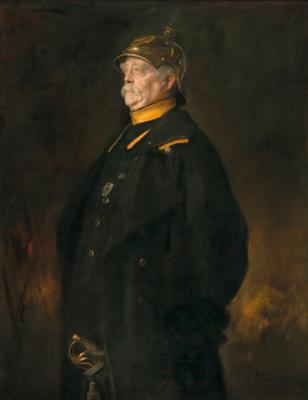Franz von Lenbach

(Schrobenhausen 1836–1904 Munich)
Portrait of Prince Otto von Bismarck (1815-1898) in the Uniform of His Halberstadt Cuirassier Regiment with Helmet and Sword, knee-length portrait, signed, dated F. Lenbach, 1 April 1892 Friedrichsruh, oil on canvas, 147 x 116 cm, framed
Provenance:
Leo Spik Berlin, 31 March 1971, lot 114;
since than Private Collection, Germany.
Exhibited:
Große Berliner Kunstausstellung, Berlin 1899, cat. no. 602; Internationale Kunstausstellung, Munich, 1905.
Catalogued in:
Adolf Rosenberg, Lenbach, Bielefeld 1898, p. 41, no. 34.
Often referred to as “Munich´s painter prince”, Franz von Lenbach became one of the most famous artists during his lifetime, primarily through his portraits. Among others, he portrayed the Austrian Emperor Francis Joseph I, the German Emperors William I and William II and—during an extended stay in Rome—Pope Leo XIII. Intending to work in the business of his father, a master bricklayer, he first completed an apprenticeship as a journeyman bricklayer and took lessons in drawing figures. From then on, he used his free time intensively to paint oil pictures in nature as well as to copy well-known works in galleries. A short time later he was able to continue his artistic training at the Academy of Fine Arts in Munich and was accepted into the painting class of Karl Theodor von Piloty in 1857. The latter was considered one of the most important representatives of realistic history painting.
Lenbach benefited from a general upswing in the arts in the mid-19th century, which resulted in the opening of several art associations and galleries. In addition, he enjoyed a good relationship with Piloty, who frequently arranged commissions for his students. In 1862, Lenbach moved to the Grand Ducal School of Art in Weimar as a professor, where he developed his own style of portraiture that emphasised the individual characteristics of his models. After his return to Munich in 1866, he opened his own studio and concentrated entirely on portrait painting. In contrast to his earlier views, he was now less concerned with a naturalistic rendering than with ennobling the sitter through the depiction and positively emphasising their features.
Franz von Lenbach held a special, lifelong bond with Otto von Bismarck (1815-1898), whom he first met in 1874. The German Chancellor had made a major contribution to the founding of the Empire three years earlier. A personal friendship developed and Lenbach regularly spent time in the Bismarck family circle. He took part in family life as a guest at Christmas parties and birthdays. Lenbach’s 80 or so portraits of the Chancellor in the following decades were copied in large numbers and still influence Bismarck’s public image today. The style of depiction varies between the private man in frock coat or hunting clothes and official presentation in uniform. The latter can be seen in the present painting. Bismarck wears the Order of the Iron Cross and his characteristic Prussian spiked helmet, known as ‘Pickelhaube’. The portrait was painted on 1 April 1892 in Friedrichsruh, exactly on Bismarck’s 77th birthday. By that time he was no longer in the service of the Empire. The fact that Lenbach nevertheless chose to depict him in uniform may refer to the outrage over the Chancellor’s dismissal in 1890. Friedrichsruh manor is located east of Hamburg in the so-called Sachsenwald, a personal gift from Emperor WIlliam I to the Chancellor. Bismarck had it rebuilt and made it his main residence from 1871. He found his final resting place in a mausoleum not far from the manor.
Esperta: Mag. Dimitra Reimüller
 Mag. Dimitra Reimüller
Mag. Dimitra Reimüller
+43-1-515 60-355
19c.paintings@dorotheum.at
10.05.2022 - 16:00
- Prezzo realizzato: **
-
EUR 20.480,-
- Stima:
-
EUR 18.000,- a EUR 25.000,-
Franz von Lenbach
(Schrobenhausen 1836–1904 Munich)
Portrait of Prince Otto von Bismarck (1815-1898) in the Uniform of His Halberstadt Cuirassier Regiment with Helmet and Sword, knee-length portrait, signed, dated F. Lenbach, 1 April 1892 Friedrichsruh, oil on canvas, 147 x 116 cm, framed
Provenance:
Leo Spik Berlin, 31 March 1971, lot 114;
since than Private Collection, Germany.
Exhibited:
Große Berliner Kunstausstellung, Berlin 1899, cat. no. 602; Internationale Kunstausstellung, Munich, 1905.
Catalogued in:
Adolf Rosenberg, Lenbach, Bielefeld 1898, p. 41, no. 34.
Often referred to as “Munich´s painter prince”, Franz von Lenbach became one of the most famous artists during his lifetime, primarily through his portraits. Among others, he portrayed the Austrian Emperor Francis Joseph I, the German Emperors William I and William II and—during an extended stay in Rome—Pope Leo XIII. Intending to work in the business of his father, a master bricklayer, he first completed an apprenticeship as a journeyman bricklayer and took lessons in drawing figures. From then on, he used his free time intensively to paint oil pictures in nature as well as to copy well-known works in galleries. A short time later he was able to continue his artistic training at the Academy of Fine Arts in Munich and was accepted into the painting class of Karl Theodor von Piloty in 1857. The latter was considered one of the most important representatives of realistic history painting.
Lenbach benefited from a general upswing in the arts in the mid-19th century, which resulted in the opening of several art associations and galleries. In addition, he enjoyed a good relationship with Piloty, who frequently arranged commissions for his students. In 1862, Lenbach moved to the Grand Ducal School of Art in Weimar as a professor, where he developed his own style of portraiture that emphasised the individual characteristics of his models. After his return to Munich in 1866, he opened his own studio and concentrated entirely on portrait painting. In contrast to his earlier views, he was now less concerned with a naturalistic rendering than with ennobling the sitter through the depiction and positively emphasising their features.
Franz von Lenbach held a special, lifelong bond with Otto von Bismarck (1815-1898), whom he first met in 1874. The German Chancellor had made a major contribution to the founding of the Empire three years earlier. A personal friendship developed and Lenbach regularly spent time in the Bismarck family circle. He took part in family life as a guest at Christmas parties and birthdays. Lenbach’s 80 or so portraits of the Chancellor in the following decades were copied in large numbers and still influence Bismarck’s public image today. The style of depiction varies between the private man in frock coat or hunting clothes and official presentation in uniform. The latter can be seen in the present painting. Bismarck wears the Order of the Iron Cross and his characteristic Prussian spiked helmet, known as ‘Pickelhaube’. The portrait was painted on 1 April 1892 in Friedrichsruh, exactly on Bismarck’s 77th birthday. By that time he was no longer in the service of the Empire. The fact that Lenbach nevertheless chose to depict him in uniform may refer to the outrage over the Chancellor’s dismissal in 1890. Friedrichsruh manor is located east of Hamburg in the so-called Sachsenwald, a personal gift from Emperor WIlliam I to the Chancellor. Bismarck had it rebuilt and made it his main residence from 1871. He found his final resting place in a mausoleum not far from the manor.
Esperta: Mag. Dimitra Reimüller
 Mag. Dimitra Reimüller
Mag. Dimitra Reimüller
+43-1-515 60-355
19c.paintings@dorotheum.at
|
Hotline dell'acquirente
lun-ven: 10.00 - 17.00
kundendienst@dorotheum.at +43 1 515 60 200 |
| Asta: | Dipinti dell’Ottocento |
| Tipo d'asta: | Asta in sala con Live Bidding |
| Data: | 10.05.2022 - 16:00 |
| Luogo dell'asta: | Wien | Palais Dorotheum |
| Esposizione: | 30.04. - 10.05.2022 |
** Prezzo d'acquisto comprensivo di tassa di vendita e IVA
Non è più possibile effettuare un ordine di acquisto su Internet. L'asta è in preparazione o è già stata eseguita.
